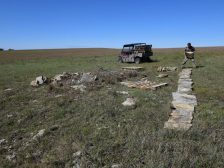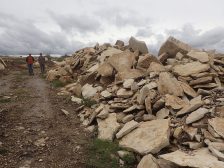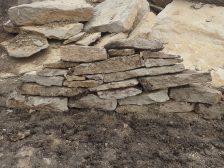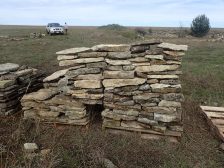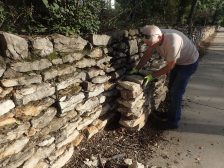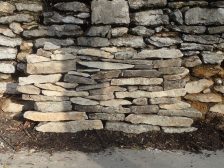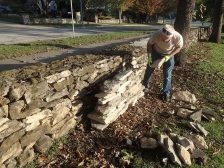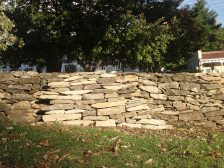Stone Collection AG, 15 Oct 2018
Collection of stone has been more complicated than I thought. The difficulties are not uninteresting and in the long run will, I hope, make the work more meaningful.
I had intended to use quarried stone, but I hadn’t anticipated how the freshly quarried stone would stand out in contrast to the weathered walls at the Nelson-Atkins.
A visit to a new wall being constructed at the Tall Grass National Preserve alerted me to the dangers of using fresh quarried stone at the Nelson-Atkins. The construction is being overseen by Neil Rippingale, a waller originally from the area in which I live in Scotland and who I brought to Canada for a project at the Cirque du Soleil many years ago. It was nice to meet him here.
I want Walking Wall to feel connected to other walls in the vicinity of the museum. The new Prairie Centre wall is very well made but also heavily worked and brick-like – far neater than the wall I intend to make which will be rougher and closer in spirit to nearby old prairie walls.
Walking Wall will not have a row of upright top stones as is typical of the prairie walls (and those in Britain). It will instead be flat-topped in the same way that the walls surrounding the museum are.
Alex Gnat, of Flint Hill Stone, very generously took me to see many quarries, piles of stones and old walls. I am extremely grateful for the insight he gave me into the stone, landscape and people of the Flint Hills. I have tried to find stone not just of the right shapes but also the right colour. I want a rugged but strong wall that looks at home in the grounds of the Nelson-Atkins.
I am particularly interested in an old disused quarry between Strong City and Marion that Alex took me to. It takes several years for stone to discolour and much of the stone here has been left for over thirty years.
The quarry has stone of good colour but unfortunately has a high proportion of large regular/square shaped stones that I would like to avoid using in great quantity. The stone work of Walking Wall should have a flow, movement and rhythm akin to water. To achieve this, I will need long and irregular stones – similar to those found in some of the many existing Nelson-Atkins Walls.
The Marion quarry will provide enough material for base stones, through stones and top stones. The stones being laid out in a line in the photo below are for the top of the wall.
The Marion quarry will not provide enough ordinary walling stone of the type that I would like. Fortunately, the walls of the Nelson-Atkins are a patchwork of different states of weathered stone. This will allow me to mix freshly quarried stone into the wall. A mixture will, hopefully, enable me to get stone of the right quantity as well as form and colour.
Above are photos of the freshly quarried stone. I took some of the stacked stone that you can see in the foreground of the picture and mixed it with the weathered stone from the Marion quarry, see picture below.
We then took a load of half fresh and half weathered stone to the Nelson-Atkins to see how it compared to the walls there.
I have left the stone stacked against the wall in the last image. They are only indicative of colour and stone shape. It only took a few minutes to make and is not representative of the wall we will finally make.
I am very pleased with how the stone looks. It isn’t intended to be a perfect match. There is too great a variety of stone shape and colour in the walls around the Nelson-Atkins to achieve this – even if I wanted to. The stone should be close enough, however, to feel part of the place. The final wall will be very much dependent on the type of stone that is yet to be collected.
I have to say that it was extraordinary to be in the Flint Hills – it has made. A deep impression upon me.
